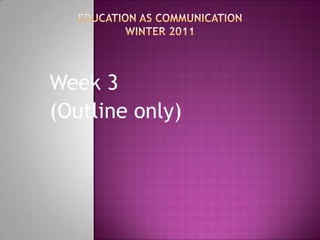
2400 week 3
- 1. Education as CommunicationWinter 2011 Week 3 (Outline only)
- 2. Week 3: Plan 1. Review of the previous class 2. Key concept for today: classroom management 3. Signs in classroom communicationand classroom management 4. Application: Analysis of the mockumentary Summer Heights High Break 5. Practice seminar & seminar assignment 6. Charting Educational Landscapes (CED) project: Q/A 8. Summary and intro to Week 3
- 3. Key concept: Classroom Management and Discipline Write down what you mean by classroom management and discipline. What is the relationship between the two. (group work)
- 4. teaching as communicating in signs Communication is grounded in the interpretations resulting from the sending, emitting, and receiving of signs of all kinds. Communication has to do with our interactions with others and with how we make sense of our worlds. Communication extend to how we deal with people. In order to become a good teacher and classroom manager, one must first become a GOOD COMMUNICATOR and, it follows, a good READER AND USER OF SIGNS.
- 5. Verbal signs Classrooms are highly verbal places, with a strong emphasis on written and especially spoken language Law of two-thirds (Flanders, 1963). Do you agree? Discourse Instructional Questioning (information and elicitation Q’s) Types of questions: personal, to check comprehension and knowledge, to advance the lesson, evaluation, divergent questions (creative thinking)
- 6. Questioning: DO’s Listen actively Give time fro student responses Avoid questions that can be answered ‘yes/no’ Ask the question, then name the student
- 7. Questioning: DOnt’s Put the student down for her/his answer Get into the habit of repeating the answer Ask the inattentive student Use fill-in-the-blank kinds of questions
- 8. Questioning: encouragment Show respect; care about the answer (listen to it!) Distribute and tailor questions Give encouragement as well as positive statements Model curiosity; ask authentic questions Allow time for students to wonder and ask Encourage self-questioning and independent and joint searching for answers; do not help too much.
- 9. non-Verbal signs All elements in communication that are not essentially linguistic in nature. Environmental factors: school and classroom size Proxemics – the meaning and use of one’s social and personal space. Proxemicsis related to the environmental factors: different spatial configurations of desks and tables (lead to different classroom dynamics for the students and teachers present.) Kinesics: body movement, posture, and facial and eye behaviour. Q: How do you know when teachers are enthusiastic about teaching their subjects? Paralanguage – non-linguistic accompaniments to speech (voice volume, tempo, pitch, intensity, hesitations and pauses) Artefacts – manipulated objects in contact with the interacting persons (e.g., perfume, clothes, eyelassesor contact lenses, lipstick, earrings, assorted beauty aids, etc.). They should be jugded within the total context of the moment!
- 10. Summer Heights high http://www.youtube.com/watch?v=tGq4shb_O3Y Watch the YouTube video and analyze the intereaction/communication. Pay special attention to non-verbal factors: environmental, proxemics, kinesics, paralanguage, artefacts, etc. Post your comments on YouTube
- 12. CLASSROOM MANAGEMENT http://www.youtube.com/watch?v=B4b8GQ-2YfU&feature=related Assess the video according to the principles below from Smith (p. 101). Post the comments on YouTube 1. Focusing principle 2. Principle of direct instruction 3. Monitoring principle 4. Modelling principle 5. Cuing principle 6. Principle of environmental control 7. Principle of low profile intervention 8. Principle of assertive discipline 9. I-message principle 10. Principle of positive reinforcement
- 13. break
- 14. Practice seminar & seminar assignment
- 15. Summary and Intro to Week 4 Key concepts for the next week: language, multilingualism Lecture: Multilingualism Applications: Language in public spaces and places: educational and pedagogical possibilities